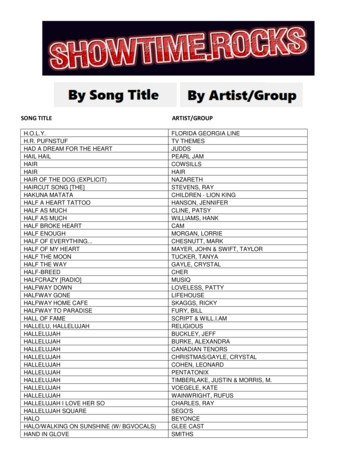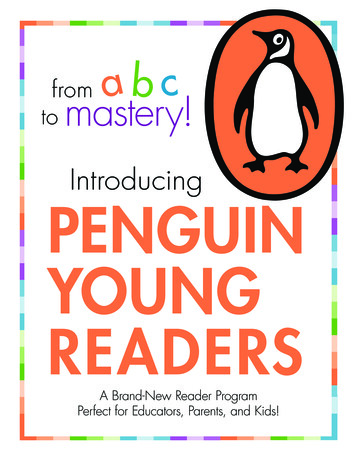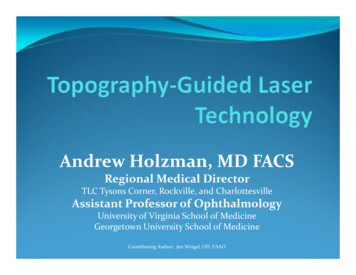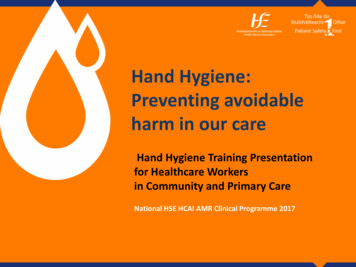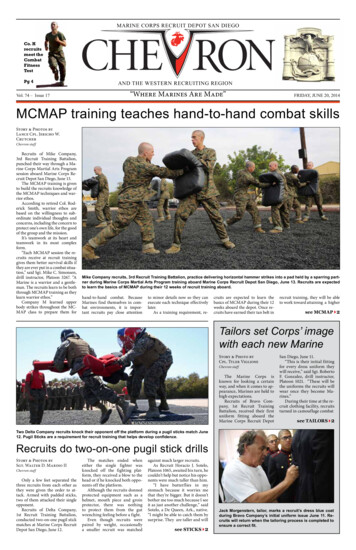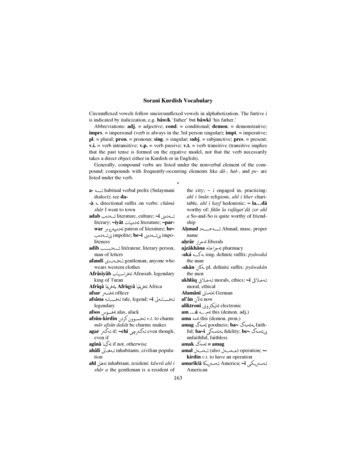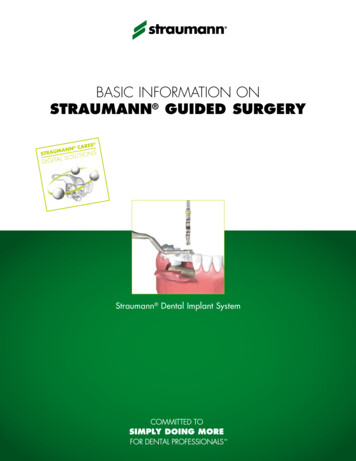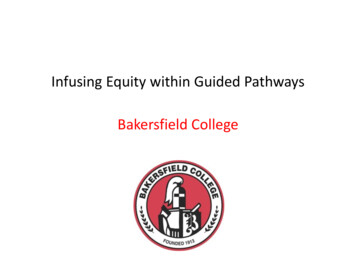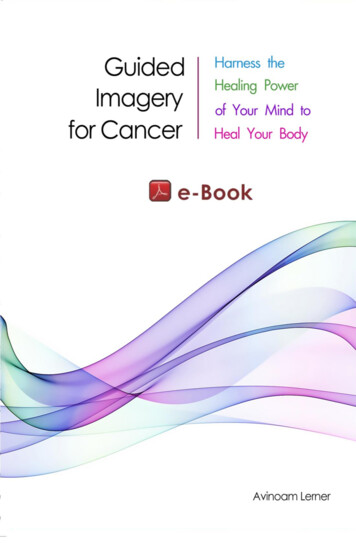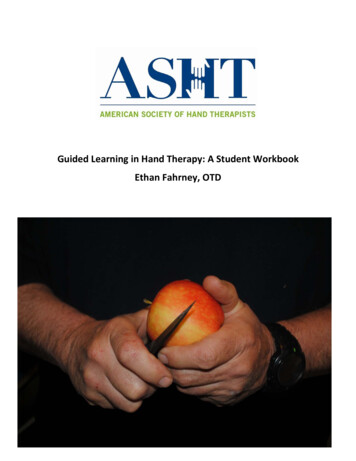
Transcription
Guided Learning in Hand Therapy: A Student WorkbookEthan Fahrney, OTD
Table of ContentsIntroduction3Anatomy and Physiology5Kinesiology20Diagnoses of the Upper Limb25Evaluation and Assessment38Therapeutic Interventions48Suggested Readings54References551
I would like to extend my gratitude to Karol Spraggs‐Young and Nathan Short fortheir guidance during the creation of this project. I would also like to thank andacknowledge Carlos A. Suárez‐Quian for giving me permission to include hisanatomy images in this workbook. This project is dedicated to the members of theHuntington University Hand and Orthopedic Interest Club.I would also like to extend my gratitude to Mr. Mark Zavoyna, Manager of theAnatomical Donor Program at Georgetown University Medical Center for hisoutstanding work preparing the cadavers used in this workbook and to thecadaveric donors for their generous gift.Many of the following images in this text were first published in All‐in‐OneAnatomy Exam ReviewImage‐Based Questions & Answers. Volume 1. Back and Upper Limb by Carlos A.Suárez‐Quian & Joel A. �one‐anatomy‐exam‐review/id9312779442
Introduction“Hand therapy is the art and science of rehabilitation of the upper limb, which includes the hand, wrist,elbow and shoulder girdle. It is the merging of occupational and physical therapy theory and practice thatcombines comprehensive knowledge of the structure of the upper limb with function and activity. Usingspecialized skills in assessment, planning and treatment, hand therapists provide therapeutic intervention toprevent dysfunction, restore function and/or reverse the progression of pathology of the upper limb in orderto enhance an individual’s ability to execute tasks and to participate fully in life situations.”1 The currentprerequisites to becoming a Certified Hand Therapist include three years of practice as a licensed occupationaltherapist or physical therapist, a minimum of 4,000 hours of direct care to patients with upper extremityconditions, and a qualifying score on the Hand Therapy Certification Examination.2Specialty practice in hand therapy necessitates advanced training beyond that of an entry‐levelclinician. Many of the clinical concepts and principles applied in hand therapy practice extend beyond theformal educational standards of occupational therapy and physical therapy entry‐level programs. Sixcompetencies for hand therapy have been outlined to include: Clinical judgment/clinical reasoning, scientificknowledge, technical skills, interpersonal and communication, professionalism, and resource management.3One study has identified areas in which clinicians feel students should be proficient before a formal clinicalrotation with a certified hand therapist. Anatomy and physiology, diagnoses of the upper limb, evaluation andassessment, and therapeutic interventions were rated most highly regarding the level of knowledge studentsshould possess before clinical rotations.4The purpose of this text is to address some of the barriers that have been outlined in the literature.3 Bysupplementing the current education provided in entry‐level occupational therapy and physical therapyprograms with student‐driven, multimodal learning strategies focused on reinforcing relevant upper extremitycontent; students will be better prepared to enter clinical rotations in hand therapy. The contents of this3
workbook narrow the focus of the user to basic principles, common conditions, and general treatmentinterventions as they prepare for a clinical placement in hand therapy. This text is not comprehensive by anymeans and should serve as a starting point for independent study.The user of this text should plan on engaging in learning activities that involve critical reasoning,memorization, and experiential learning. Research has begun to establish a consensus for content inclusion inentry‐level therapy education related to hand therapy.5 You may feel confident that the specific content areasincluded in this resource were identified by clinicians as being highly relevant. Find a partner, stay engaged inthe learning experience, and reflect on your strengths and weaknesses as you navigate through this text. Keepin mind that skill and knowledge acquisition occur at different rates for everyone. To encourage the user toidentify reliable sources, there is no answer key provided for The Student Workbook. However, throughoutthis text you will find suggested readings and resources that will point you down the path to finding theinformation you will need.4
Anatomy and PhysiologyPurposeThe human hand and upper extremity give us the power to interact with and manipulateour environment. Much like a mechanic must know the parts and pieces of a combustionengine, it is necessary for a hand therapist to understand the parts and pieces of the upperextremity. Muscles, tendons, ligaments, blood vessels, nerves, and bones come together tocompose the machine that allows us to make art and heal the sick. Dysfunction in one link ofthe chain can lead to a breakdown of the machine and a subsequent decrease of engagementin purposeful activities. The study of human anatomy and physiology provides a foundation forthe work of a hand therapist and informs decision making throughout the rehabilitativeprocess. The fundamental knowledge in this section will provide you with a sturdy platformfrom which to build your understanding of the complex topics related to the upper extremity.Learning Objectives1. The student will be able to identify clinically significant anatomical landmarks of theupper extremity2. The student will be able to able to accurately depict the structure of brachial plexus3. The student will be able to accurately plot the course of the peripheral nerves of theupper extremity4. The student will be able to identify potential nerve compression sites of the upperextremity5. The student will develop increased proficiency with the identification of upper extremitymuscles, their attachments, and actions.5
Skeletal AnatomyLabel the following structures:A.B.C.D.Adapted with permission. Carlos A. Suárez‐Quian, Ph.D. Department of Biochemistry and Molecular & Cellular Biology Georgetown University Medical CenterLabel the following structures or landmarksA.B.C.D.E.F.G.H.Adapted with permission. Carlos A. Suárez‐Quian, Ph.D. Department of Biochemistry and Molecular & Cellular Biology Georgetown University Medical Center6
Identify the structures shown to the leftA.B.C.D.E.F.G.H.I.Adapted with permission. Carlos A. Suárez‐Quian, Ph.D. Department of Biochemistry and Molecular & Cellular Biology Georgetown University Medical CenterIdentify the structures shown to the left:A.B.C.D.E.F.G.H.Adapted with permission. Carlos A. Suárez‐Quian, Ph.D. Department of Biochemistry and Molecular & Cellular Biology Georgetown University Medical Center7
Identify the carpal bones1.2.3.4.5.6.7.8.Adapted with permission. Carlos A. Suárez‐Quian, Ph.D. Department of Biochemistry and Molecular & Cellular Biology Georgetown University Medical CenterUseful Links:https://youtu.be/kNxXudmTt‐Y?t 438 (Upper Limb: Surface Anatomy & Osteology)https://youtu.be/n5LSiRyALLA (Bones of the Upper /bones/ (TeachMeAnatomy)https://youtu.be/XueiXe8bcDg (Learning the Carpal Bones)8
Muscles of the Upper QuarterComplete the following chart:MuscleAbductor bductorpollicis brevisAbductorpollicis longusAdductorpollicisAnconeusBiceps ltoidDorsalinterosseiExtensor carpiradialis brevisExtensor carpiradialis longusExtensor carpiulnaris9
Extensor digitiminimiExtensordigitorumExtensor indicisExtensor pollicisbrevisExtensor pollicislongusFlexor carpiradialisFlexor carpiulnarisFlexor msuperficialisFlexor pollicisbrevisFlexor pollicislongusInfraspinatusLatissimus dorsiLevatorscapulae10
Lumbricals (1stand 2nd)Lumbricals (3rdand 4th)Opponens is brevisPalmaris longusPectoralis majorPectoralis minorPronatorquadratusPronator clavius11
SubscapularisSupinatorSupraspinatusTeres majorTeres minorTrapeziusTriceps brachiiActivities:A. Go to pparatus/ and complete the activity on yourselfWhat did you learn?B. Go to scles/ and complete the activity on yourselfWhat did you learn?12
Use the enhanced cadaver images to identify structures of the upper quarter:Identify the structures shownto the left:A.B.C.D.E.Adapted with permission. Carlos A. Suárez‐Quian, Ph.D. Department of Biochemistry and Molecular & Cellular Biology Georgetown University Medical CenterIdentify the structures shownto the left:A.B.C.Adapted with permission. Carlos A. Suárez‐Quian, Ph.D. Department of Biochemistry and Molecular & Cellular Biology Georgetown University Medical Center13
Identify the muscles of the volar shoulderand upper arm shown to the left:A.B.C.D.Adapted from Yokochi C, Rohen JW, & Weinreb EL. (1989). Photographic anatomy of the human body. Tokyo: Igaku‐ShoinIdentify the muscles and soft tissue structuresof the volar forearm shown to the left:A.B.C.D.E.Adapted from Yokochi C, Rohen JW, & Weinreb EL. (1989). Photographic anatomy of the human body. Tokyo: Igaku‐Shoin14
List the contents of each dorsalcompartment:1.2.3.4.5.6.Adapted from Yokochi C, Rohen JW, & Weinreb EL. (1989). Photographic anatomy of the human body. Tokyo: Igaku‐ShoinLabel the following structures:A.B.C.D.E.F.Adapted with permission. Carlos A. Suárez‐Quian, Ph.D. Department of Biochemistry and Molecular & Cellular Biology Georgetown University Medical Center15
NeuroanatomyIdentify the vascular andneural structures:A.B.C.Adapted with permission. Carlos A. Suárez‐Quian, Ph.D. Department of Biochemistry and Molecular & Cellular Biology Georgetown University Medical CenterDraw and label the brachial plexus16
List the muscles innervated by each peripheral nerve in their order of innervation from proximal to distal.Median nerveUlnar nerveRadial nerveSuggested Activities:1. Using non‐toxic markers, plot the courses of the branches of the brachial plexus from the shoulder tothe hand. Palpate and label following anatomical landmarks along the nerve pathways.a. Clavicleb. Acromion processc. Radial tunneld. Cubital fossae. Cubital tunnelf. Carpal tunnelg. Guyon canal2. Using non‐toxic markers, label the following landmarks on your partner:a. Distal digital creaseb. Middle digital creasec. Proximal digital creased. Distal palmar creasee. Proximal palmar creasef. Thenar creaseg. Distal wrist creaseh. Proximal wrist crease17
Physiology of Wound HealingType of WoundWound Color:Characteristics:RedYellowBlackGoals of Wound Care:Timetable for Wound HealingPhase of wound healingWhen does it begin andend?What is happening?Factors that affectwound le for Fracture HealingPhase of bone healingWhen does it begin andend?What is happening?Factors that affect modeling18
Classification of Nerve InjurySeddon’s Staging(1943)Sunderland’sStaging (1978)NeuropraxiaLevel I: NervecompressionAxonotmesisLevel II:WallergiandegenerationNeurotmesisBrief AnatomicalDescriptionUsual Cause ofNerve InjuryPrognosisLevel III:Regeneration maynot occur atoriginal endorgansLevel IV: Neuromain continuityLevel V: Completenerve transectionUseful .aspx (Resource for Regional view‐of‐upper‐limb/lablink (University of Michigan lder‐and‐brachial‐plexus/lablink (University of Michigan t‐hand‐and‐foot/lablink (University of Michigan les/lablink (University of Michigan ink/resources/practice‐questions (University of Michigan ents/m46495.html (Phil Schatz Anatomy cles (American Society for Surgery of the Hand)https://www.youtube.com/user/nabilebraheim (Nabil Ebraheim YouTube Channel)http://www.anatomyguy.com/ (The Anatomy Guy Cadaver Dissection Videos)19
KinesiologyPurposeWe must first examine how our anatomy and physiology enable engagement inpurposeful activity in the context of the upper extremity to further our understanding of theinteraction of humans and the physical world. Purposeful movement results from thesummation of muscular contractions, tendon excursions, ligamentous stability,proprioception, and sensory feedback. A compromise of any of these components can result infunctional deficits that impact the quality of life and independence. It is critical for handtherapists to understand normal functional movement patterns as a foundation to bettercomprehend the impact of dysfunctional anatomy and physiology on activity engagement.Completing this section will enhance your understanding of applied anatomy and kinesiologyin the context of the upper extremity.Learning Objectives1. The student will demonstrate a basic understanding of the principles and terminology ofkinesiology and movement analysis2. The student will be able to use activity analysis to identify the anatomy andbiomechanics involved in performing purposeful activities3. The student will be able to describe the broad relationship joint dysfunctional and theperformance of purposeful activities20
BiomechanicsDefine osteokinematics:Define arthrokinematics:Which planes of motion do the following osteokinematic movements occur in?Shoulder flexion/extensionShoulder horizontal adductionShoulder internal/external rotationElbow flexion/extensionForearm pronation/supinationWrist flexion/extensionWrist radial/ulnar deviationFinger flexion/extensionExplain the convex‐concave rule21
Identify whether the following joints are convex‐concave or lRadiocarpalMidcarpalThumb nterphalangealDart thrower’s motion is a combination which osteokinematic wrist movements?A.B.C.D.Wrist flexion / radial deviation and wrist extension / ulnar deviationWrist extension / radial deviation and wrist flexion / ulnar deviationWrist pronation / radial deviation and wrist supination / ulnar deviationWrist supination / wrist flexion and wrist pronation / wrist extensionUseful Links:https://youtu.be/‐pmfa7‐0pdI (Osteokinematics)https://youtu.be/ZNoOdVchNoo (Arthrokinematics)https://youtu.be/9pCbnvpyLvs (Concave‐Convex Rule)https://youtu.be/khCZ5WS8F6M (Levers and Mechanical Kris/videos (KinesiologyKris)22
Activity AnalysisFor the following examples, explain the osteokinematics of the shoulder, elbow, wrist, and hand. Also list the majormuscles involved in completing the task.Opening a jar of pickles Shoulder Elbow Wrist HandSauté vegetables in a pan Shoulder Elbow Wrist HandBrushing your hair Shoulder Elbow Wrist HandHammering a nail Shoulder Elbow Wrist HandCasting a fishing pole Shoulder Elbow Wrist Hand23
Playing the guitar Shoulder Elbow Wrist HandSuggested activities: To simulate joint stiffness, wrap the PIP joints of your index and long fingers using a self‐adherent compressionwrap. Engage in your morning or evening routine with your fingers wrapped to gain a better understanding ofthe difficulties that patients with PIP joint experience when performing self‐care. Attempt one‐handed shoe tying techniques and take notes of the individual joint motions required to completethe task. Place your dominant hand in a sock to prevent use while you complete your morning self‐care routine. Reflecton the activities that were easier to complete with your non‐dominant hand than you expected and which weremore difficult.Useful Links:https://youtu.be/xGL NtNhRNc (Opening a Jar)https://youtu.be/a3rgCoUpzeA?t 87 (Sautéing Vegetables in a Pan)https://youtu.be/tOiSkM9S6g8?t 183 (Brushing Hair)https://youtu.be/19RGYncQzlo (Hammering Nails)https://youtu.be/QnIxm9ujVXI?t 78 (Casting a Fishing Pole)https://youtu.be/4CAuLeSmcR8 (Person Playing Guitar)24
Diagnoses of the Upper LimbPurposeUnderstanding the underlying disease processes of common diagnoses of theupper extremity will provide the foundation for accurate evaluation, clinicaldecision‐making, and treatment interventions. This section will serve as a reviewof common conditions that you will encounter in the hand therapy clinic. Whencompleting this section, keep in mind the impact of comorbidities, lifestyle factors,and behavior on the healing process.Learning Objectives The student will develop a basic understanding of the underlyingpathology associated with common upper extremity conditions The student will develop a basic understanding of the impact of upperextremity disorders and precautions on engagement in purposefulactivities The student will increase their understanding of operative and non‐operative procedures used in the management of upper extremityconditions25
Distal Radius FractureThe term reduction, in the context of fracture management, refers to which of the following?A.B.C.D.Fracture platingAlignment of bony fragmentsCompression fracturePlacement of pinsList some advantages of plate fixation compared to external fixation in the management of distal radius fractures:Describe the fracture patterns of the following distal radius fractures:Colles’:Galleazzi:Smith’s:Why is it important to maintain active motion of the fingers and hand while the wrist is immobilized for fracture healing?26
ArthritisExplain the pathological joint changes associated with osteoarthritis:List 3 risk factors for developing osteoarthritis:1.2.3.Rheumatoid arthritis is caused by:A.B.C.D.Autoimmune processesOveruseHeavy metal exposureViral infectionIdentify the following joint positions of swan neck deformity:MCP:PIP:DIP:Identify the following joint positions of boutonniere deformity:MCP:PIP:DIP:Activity:Practice the following joint protection techniques1.2.3.4.Use the heel of your hand to open and close a jarStir a pot while holding the utensil with a cylindrical grasp and your wrist in neutralLift your cup of coffee with both handsCut vegetables while holding the knife like a dagger to avoid ulnar stress on MCPs27
Nerve CompressionCubital tunnel syndrome is a compression of the nerve at the .A. Median nerve; elbowB. Ulnar nerve; wristC. Ulnar nerve; elbowD. Median nerve; wristWhat is double crush syndrome?Identify the structures within the carpal tunnelWhich muscles are most likely to be affected by carpal tunnel syndrome?In which elbow position is the ulnar nerve under the most compression?Radial nerve palsy can result in the total loss of which active motion?A.B.C.D.Wrist flexionElbow flexionWrist extensionThumb oppositionSaturday night palsy is typically an example of which class of nerve injury?A. NeuropraxiaB. AxonotmesisC. Neurotmesis28
EdemaManagement of edema could include all the following except:A.B.C.D.ElevationCompressionPosition the limb in the dependent positionManual therapyHow does active motion mobilize lymph fluid and reduce edema?What is the effect of chronic edema on scar tissue formation following injury?What is a contraindication for using a volumeter to measure edema following an acute injury?How does lymphedema differ from edema that occurs following an injury?29
Metacarpal FracturesA fracture of the 5th metacarpal neck is known as:A. Boxer’s fractureB. Monteggia fractureC. Essex‐Lopresti fractureD. Salter‐HarrisDescribe the purpose of buddy strapping during the rehabilitation of metacarpal fractures:Identify 3 surgical fixation techniques that are used in the treatment of metacarpal fractures:1.2.3.Describe the functional implications of rotated or scissoring digits:When molding a custom orthosis, why might the therapist immobilize the digits adjacent to the fractured metacarpal?A. To provide additional stabilityB. The adjacent metacarpal is probably fractured as wellC. To provide additional cosmesisD. Immobilizing the adjacent digit is not a common practice30
TendinopathiesTennis elbow is associated with pathological changes of which tendon?A. Extensor digitorumB. Extensor carpi radialis brevisC. Extensor carpi ulnarisD. Flexor digitorum superficialisDeQuervain’s tenosynovitis involves which of the following structures?A. Zone 1 of the extensor tendonB. First dorsal interosseusC. Extensor pollicis longus and tendon sheathD. Abductor pollicis longus, extensor pollicis brevis, and tendon sheathIntersection syndrome involves which anatomical structures?Why would elbow extension increase pain when performing grip testing for a patient with lateral epicondylitis?Hawkins‐Kennedy and Neer tests are sensitive to which shoulder pathology?A. Frozen shoulderB. Rotator cuff tearC. SLAP lesionD. Subacromial impingementDescribe the RICE protocol:R.I.C.E.31
Acute Tendon InjuriesList the contents and boundaries of the following flexor tendon zones:Zone 1:Zone 2:Zone 3:Zone 4:Zone 5:List the contents and boundaries of the following flexor tendon zones:Zone 1:Zone 2:Zone 3:Zone 4:Zone 5:Zone 6:Zone 7:Zone 8:“No man’s land” is described as which flexor tendon zone?A.B.C.D.Zone 1Zone 2Zone 3Zone 4A flexor tendon injury that results in lost tendon material and is repaired under tension may result in an active flexionlag and is known as the Quadriga effect. Why does this occur?“Mallet finger” is an injury to which extensor tendon zone?A.B.C.D.Zone 1Zone 3Zone 5Zone 732
Dupuytren’s DiseaseExplain the pathological changes the occur in the hand of a person with Dupuytren’s diseasePeople with an ancestry from which geographic area appear to have a genetic predisposition to Duputren’s contracture?What are the major functional implications for a person the has developed Dupuytren’s contracture?Describe the following medical procedures:Fasciectomy:Collagenase injection and manipulation:Needle fasciotomy:33
Thoracic Outlet SyndromeName the 3 most common compression sites of the brachial plexus1.2.3.What are common symptoms of thoracic outlet syndrome that would rule out other shoulder pathologies?How do postural compromise and ergonomic factors relate to the development of thoracic outlet syndrome?Activities:1. Using a website or program like www.hep2go.com, identify and perform exercises that target the compressionsites of thoracic outlet syndrome. Also, identify and perform proximal nerve gliding exercises.2. Special tests for thoracic outlet syndrome tend to have a high incidence of false positive results in healthypopulations.6‐7 Perform Adson’s and Wright’s tests with a partner. Consider the anatomical and physiologicalfactors that could lead to a false positive result.34
Complex Regional Pain SyndromeDescribe the classifications of CRPS: Class 1 Class 2List the major signs and symptoms of CRPS:Define allodynia:Mirror visual feedback primarily promotes in the treatment of CRPS.A.B.C.D.Tendon glidingSomatosensory cortex reorganizationMuscle hypertrophyStress loadingWhat are the components of stress loading?35
Trigger FingerDescribe the underlying pathology associated with trigger fingerWhich annular pulley is most commonly involved in trigger finger?What systemic medical condition is commonly associated with increased risk for trigger finger?List the stages and symptoms associated with each stage of trigger finger?Why does forceful gripping increase triggering symptoms?Describe the surgical intervention for trigger finger:36
Useful Links:https://youtu.be/C B6eSop0sg (Distal Radius Fracture)https://youtu.be/gnAPd2OD0zk (Distal Radius ORIF with T‐plate: WARNING GRAPHIC)https://youtu.be/iSA1BSSQLPA (Basal Joint Arthritis)https://youtu.be/Gmp‐idAPOaQ (Rheumatoid Arthritis Animation)https://youtu.be/3H69oUqTgAI (Rheumatoid Arthritis)https://youtu.be/hiJDI4Pq1ng (Carpal Tunnel)https://youtu.be/jiUKeCLMS90 (Carpal Tunnel Surgery: WARNING GRAPHIC)https://youtu.be/VLVIpR‐Dqbw (Metacarpal Fracture)https://youtu.be/RPPynbZjC7Q (1st Extensor Compartment Release: WARNING GRAPHIC)https://youtu.be/boMlEa3P43g (FDP Tendon Repair: WARNING GRAPHIC)https://youtu.be/cHq8I8gfv50 (Thoracic Outlet Syndrome Surgical Correction: WARNING GRAPHIC)https://youtu.be/AB‐KtVA2 fo (Dupuytren’s Release: WARNING GRAPHIC)https://youtu.be/Bugg0fpzwj8 (Complex Regional Pain Syndrome)https://youtu.be/0VSxtk1oQ2s (Trigger Finger Injection)37
Evaluation and AssessmentPurposeTo develop a safe and appropriate treatment plan, it is essential for thetherapist to have a thorough understanding of the physical, social, andpsychological factors associated with injury and recovery. Hand therapists arerequired to make clinical decisions based on the results of evaluation andassessment. The ability to perform an informative evaluation is dependent on thetherapist’s ability to assess the physical structures involved, the quality ofmovement, and the underlying pathology. The behavioral influence of social andpsychological factors may also have an impact on healing and patient compliance.The evaluation process helps illustrate the many variables that can affect patientoutcomes, positively or negatively. The purpose of this section is to introducesome of the terminology and assessment tools commonly used in clinical practice.Developing comfort with measurement and assessment tools will promoteconfidence and self‐efficacy during the clinical learning experience.Learning Objectives: The student will improve their understanding of the selection and purposeof basic evaluation techniques The student will gain exposure to basic evaluation techniques throughengagement in hands‐on learning activities The student will be introduced to common terminology anddocumentation necessary for accurate evaluation and assessment38
Match the following statements with the appropriate section of a SOAP note.S SubjectiveO ObjectiveA AssessmentP PlanNegative Froment’s SignPt states they were able to tie their shoes over the weekendPt rates pain 10/10Pt states they were independent with all ADLs prior to injuryPt states they have been unable to complete components of dressing and meal preparation since the time of theirinjuryPt reports burning pain that extends into the hand.Pt states the pain is located at the base of her thumbPt reports he would like to return to work without restrictionsRight wrist extension AROM 10 degreesPt presents with good rehab potentialContinue therapy 1 time per week for 4 weeksPt’s major limiting factors include intrinsic tightness, scar sensitivity, and edema.progress to gentle strengthening activities next visitR grip strength 74# L grip strength 21#QuickDASH score 50%Pt demonstrates diminished protective sensation in the ulnar distribution of the L hand and fingers39
Define the following commonly used abbreviations RUE, LUE D1, D2, D3, D4, D5 TH, IF, LF, RF, SF P1, P2, P3 IR, ER FLEX, EXT AROM AAROM PROM MMT TAM DRUJ TFCC CMC MCP PIP DIP IP FX DRF ORIF EX FIX SLAP AVN CTS CuTS LRTI PRC DASH HEP TENS NMES40
With a partner, determine the active range of motion for each movementShoulder flexion/extensionShoulder horizontal adductionShoulder internal/external rotationElbow flexion/extensionForearm pronation/supinationWrist flexion/extensionWrist radial/ulnar deviationFinger flexion/extensionPalpate the following bony landmarksClavicleHumerusRadial shaftAcromion endGreater tubercleRadial styloidSternal endLesser tubercleLister’s tubercleShaftIntertubercular grooveCarpusDeltoid tuberosityCapitateMedial borderMedial epicondyleScaphoidInferior angleLateral epicondyleTrapeziumScapulaAcromion processUlnaLunateSpine of scapulaOlecranon processPisiformInfraspinous fossaUlnar shaftTriquetrumSupraspinous fossaUlnar headHamateSubscapular fossaUlnar styloidSternumRadiusRadial headHandMetacarpalsPhalanges41
Palpate the following muscles with a partnerTrapeziusUpper trapeziusMoving your fingers laterally from the base of the skull to the clavicle, notice the contraction of theupper trapezius as your partner extends their neck.Middle trapeziusWith your partner in the prone position, have them abduct their arm in the scapular plane and retracttheir scapula. Notice the active contraction of the middle trapezius between the spinous processes ofthe thoracic region and the medial border of the scapula.Lower trapeziusPalpate the spinous process of T12 on your partner. Move your fingers in the direction of the inferiorangle of the scapula as your partner actively holds their arm in the scapular plane.Levator scapulaeWith your partner in the prone position, place their hand in the small of their back. Place your fingers on themuscle belly just above superior to the superior angle of the scapula. Have your partner actively shrug theirshoulder while you move your fingers in the direction of the upper cervical spine.RhomboidsHave your partner place their hand in the small of their back. Place your fingers on the medial border of thescapula. Notice the contraction of the rhomboids as your partner lifts their hand off of the small of thei
Anatomy and Physiology Purpose The human hand and upper extremity give us the power to interact with and manipulate our environment. Much like a mechanic must know the parts and pieces of a combustion engine, it is necessary for a hand therapist to understand the parts and pieces of the upper
